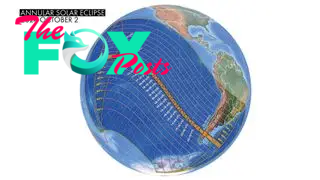Science
Watch live: A 'ring of fire' solar eclipse has begun over Easter Island
Right now, the moon's shadow is racing across the Pacific Ocean, creating a spectacular "ring of fire" eclipse that will soon be visible to skywatchers on Easter Island and the tip of South America.
If you're not located within the path of the eclipse — also called the path of annularity — don't fret. You can watch the whole thing unfold for free via the livestream below, courtesy of timeanddate.com. The partial phase of the eclipse has already begun, and the peak phase will last from 3:03 to 3:09 p.m. EDT (1903 to 1909 GMT), as seen from the Pacific island of Rapa Nui — a tourist destination better known as Easter Island.

The Oct. 2 event is a type of partial eclipse known as an annular solar eclipse. All solar eclipses occur when the moon is positioned precisely between Earth and the sun, always coming two weeks after a full moon. (The last one was September's Harvest Moon, which also featured a partial lunar eclipse.)
However, unlike the April 8 total solar eclipse that dazzled millions of skywatchers across North America, the moon is a bit further from Earth now and will never completely block out our view of the sun today, only covering about 93% of the sun's center.
Related: When is the next solar eclipse?

This will result in a brilliant "ring of fire" encircling the dark moon for several minutes during the peak phase of the eclipse. It also means viewers on the ground MUST ALWAYS view the eclipse through solar eclipse glasses or solar-filtered telescopes, as the brightest part of the sun will never be fully blocked like it was in April.
—Earth hit by radiation from rare 'double' X-class solar flare
—Gargantuan sunspot 15-Earths wide shoots powerful X-class flare toward Earth
—Sun fires off double-barreled X-class flares in span of 2 hours
Today's annular eclipse will also follow a much less populated path than April's total eclipse did, with only an estimated 175,000 people living in the path of annularity, according to spaceweather.com. The eclipse will pass over Rapa Nui at roughly 3 p.m. EDT, then will cross the Pacific for several hours before reaching southern Chile and Argentina around 4:20 p.m. EDT. The "ring of fire" phase will last a maximum of 6 and a half minutes over Rapa Nui, and between 3 and 6 minutes over South America.
-

 Science6h ago
Science6h agoHere’s What Trump’s Win Means for NASA
-

 Science3d ago
Science3d agoWhy Risky Wildfire Zones Have Been Increasing Around the World
-

 Science3d ago
Science3d agoIt’s Time to Redefine What a Megafire Is in the Climate Change Era
-

 Science4d ago
Science4d ago4 Astronauts Return to Earth After Being Delayed by Boeing’s Capsule Trouble and Hurricane Milton
-

 Science5d ago
Science5d agoThe Elegance and Awkwardness of NASA’s New Moon Suit, Designed by Axiom and Prada
-

 Science1w ago
Science1w agoSpaceX Launches Its Mega Starship Rocket. This Time, Mechanical Arms Catch It at Landing
-

 Science3w ago
Science3w agoYou Won’t Want to Miss October’s Rare Comet Sighting. Here’s How and When You Can See It
-

 Science1m ago
Science1m agoA New Spacecraft Could Help Determine if There’s Life on a Moon of Jupiter



























